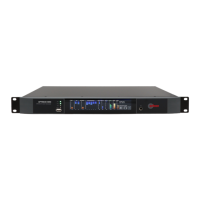Orban 5950 Technical Manual Technical Data 6-11
)LJXUH-0XOWLSOH[SRZHURYHUPLQXWHREVHUYDWLRQLQWHUYDO
ZLWK0XOWLSOH[SRZHUFRQWUROOHUDFWLYHPHDVXUHGDWWKH2SWLPRG¶VFRPSRVLWHRXWSXW
If your country enforces the standard, you should set the control to complement the amount of peak overshoot in
the transmission system following the 5950. Setting the control at “0” will correctly control the multiplex power
when there is no overshoot after the 5950. This will typically be true when you are using your Optimod’s built-in
stereo encoder to drive the transmitter directly.
Many paths have overshoot and this forces you to reduce the average modulation to avoid overmodulating the
transmitter. This would reduce the multiplex power by the same amount, forcing the multiplex power below the
ITU requirement.
To compensate for this, match the 0
8/7,3/(; 32:(5 7+5(6+2/' control to the peak overshoot of the
transmission system following the 5950. For example, if RF peak deviation exceeds the peak deviation produced by
the 5950’s sinewave oscillator (set for 100% modulation) by 3 dB, set the 08/7,3/(;32:(57+5(6+2/'to “+3.”
Audio Processing and the Multiplex Power Threshold Control
The multiplex power controller reduces multiplex power by applying gain reduction after the Optimod’s FM peak
limiting system, which reduces the tendency of the MPX power controller to produce unnatural-sounding gain
reduction because the standard forces MPX power to be measured after preemphasis and without psychoacoustic
weighting.
With no power control, some of the louder 5950 presets can exceed the ITU standard by as much as 16 dB. This
means that the controller must reduce gain by as much as 16 dB depending on the dynamics and spectral content
of the input program material. To prevent unnatural loudness variations, your Optimod applies a static loss (preset-
dependent and set by the 0
8/7,3/(;32:(52))6(7control) before the FM peaks limiters when the multiplex
power controller is activated. This complements the dynamic gain reduction produced by the multiplex power
controller.
The MPX offset is applied before the peak limiters. Turning it up (for example, from –12 to –9 dB) increases both
the amount of peak limiting and the amount of wideband gain reduction performed by the MPX Power Controller
The multiplex power controller does not use the output of the 5950’s stereo encoder as its reference. Instead, it
computes the multiplex power directly from the left and right audio signals, the setting of the 3,/27/(9(/ control,
and the setting of the &20326,7(/,0,7'5,9( control. Hence, the multiplex power controller does not take into
account the effect of any composite limiting on the multiplex power. This is not a problem because a BS412-
compliant broadcast does not cause enough composite limiting to affect the multiplex power measurably. The
purpose for this change was to allow the multiplex power controller to work even when diversity delay is applied to
the stereo encoder.
The multiplex power controller is operational with all of the Two-Band and Five-Band processing structures. It is not
active in Test mode and will not prevent the 5950’s test oscillator from producing illegal modulation. It is the
responsibility of the operator to make sure that the test oscillator does not violate the ITU requirements.

